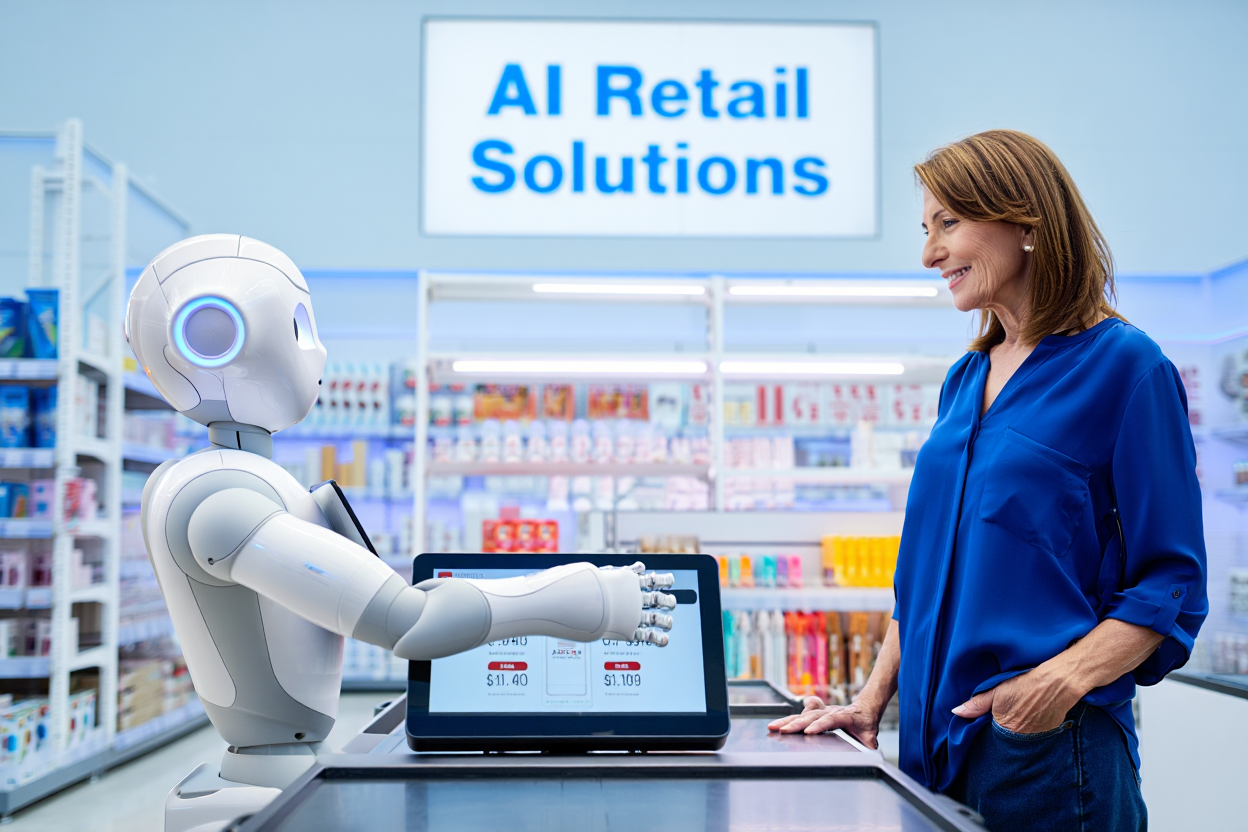
The retail industry is standing on the edge of a digital revolution, and Artificial Intelligence (AI) is the driving force pushing it forward. What used to be a traditional, linear business model is now becoming smart, agile, and hyper-connected, all thanks to the integration of AI technologies. Whether it’s your neighborhood grocery store or a global fashion brand, AI is quietly transforming how products are stocked, how customers are served, and how profits are made.
Table of Content
Artificial intelligence (AI) in retail is changing the way retailers run and interact with customers. AI helps retailers automate critical operations, enhance decision-making, and swiftly adjust to changing customer expectations by leveraging real-time data and intelligent insights. AI is propelling a new era of innovation in the retail industry, from efficient processes to tailored experiences.
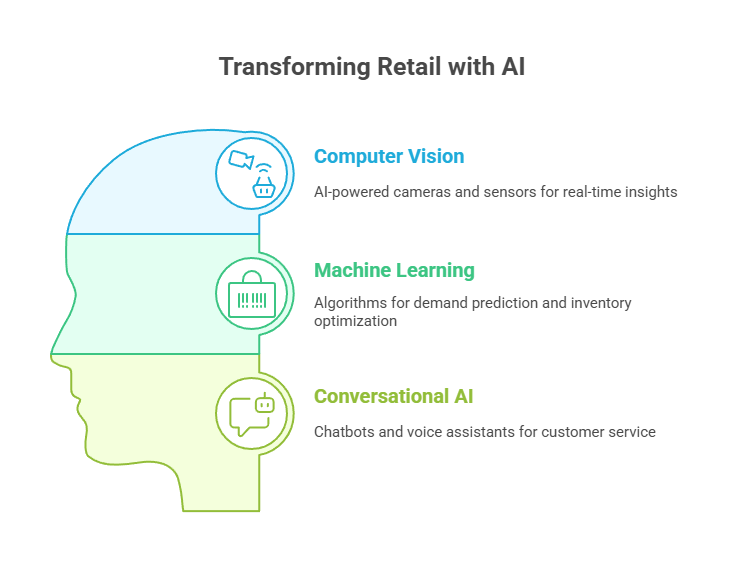
Why AI in Retail?
AI is reshaping the retail industry from the ground up. It’s no longer just about selling products — it’s about creating smarter, faster, and more personalized shopping journeys. Here’s how AI is making a difference:
Retailers that fully embrace AI not just as a tool, but as a core strategy will have a significant edge. They’ll connect more meaningfully with customers, operate more efficiently, and stay competitive in today’s fast-moving, AI-powered marketplace
Why Now Is the Tipping Point for AI Adoption
So why is AI adoption exploding in retail right now? Several key factors have aligned to create the perfect environment for AI integration:
We’re at a moment where AI is no longer just a futuristic concept, it’s a practical, proven solution being used by businesses of all sizes to drive real results.
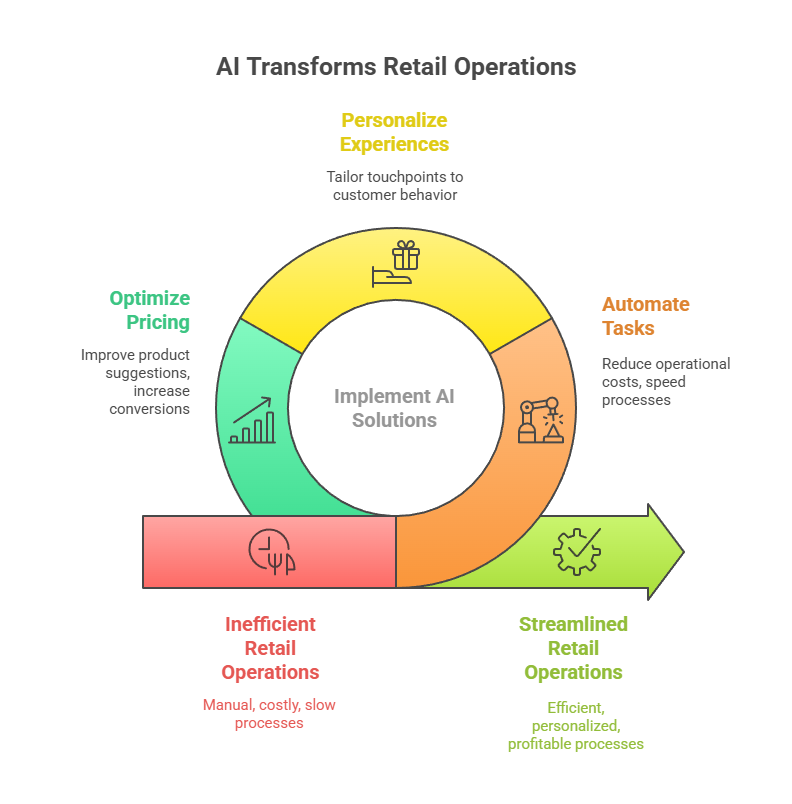
At its core, AI is a business enabler — one that delivers powerful results across three crucial pillars:
In short, AI is reshaping retail from the ground up. It’s turning data into insights, insights into actions, and actions into results. And with the barriers to entry lower than ever, now is the time for retailers—big and small—to invest in the future.
Top retail brands like Amazon, Walmart, Zara, and Sephora have already embraced AI to boost customer satisfaction, cut costs, and streamline operations. Whether it’s through AI-powered chatbots, predictive analytics, or smart shelf monitoring, these companies are proving that AI isn’t just a trend — it’s a necessity for survival in the modern retail world.
In this article, we’ll take a deep dive into how artificial intelligence is transforming retail. From inventory and pricing to customer service and logistics, we’ll explore why top brands are investing in AI — and why you should too.
The Strategic Importance of AI for Leading Retailers
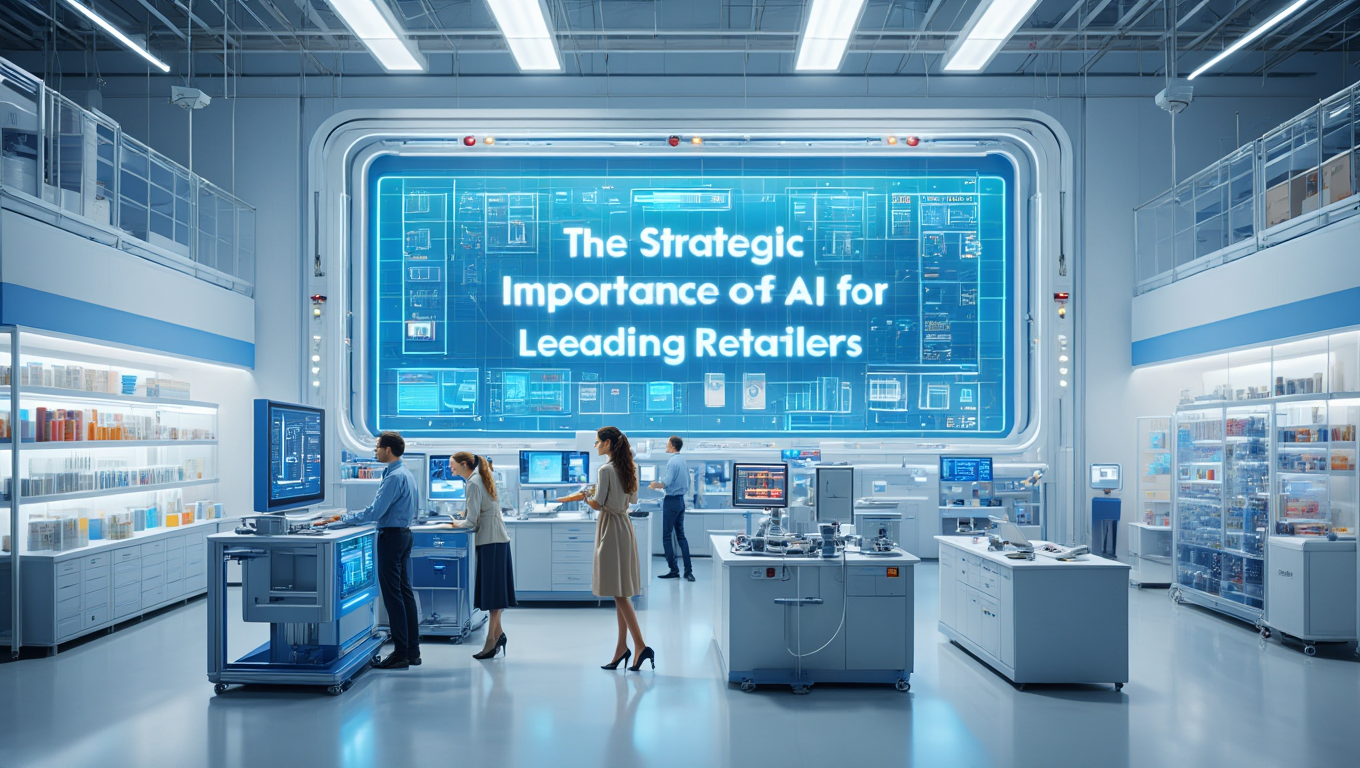
Let’s talk about strategy. Why are so many leading retailers betting big on artificial intelligence? The answer lies in one simple fact: AI offers a massive competitive advantage.
Retailers are always on the hunt for ways to increase revenue, reduce costs, and offer better customer experiences. Traditional tools are no longer enough to achieve these goals. That’s why AI is now being used to make smarter decisions, faster, and often more accurately than humans can.
Take dynamic pricing, for example. AI algorithms can analyze competitor prices, consumer behavior, and market trends in real-time to adjust prices instantly. This helps retailers stay competitive without sacrificing profit margins. Another strategic benefit is customer personalization. With AI, brands can create highly personalized shopping experiences that boost engagement and conversions. Think of Netflix-style recommendations, but for fashion or groceries.
AI is also playing a big role in workforce management and inventory planning. By analyzing historical data and current trends, AI can forecast demand more precisely, helping businesses avoid overstock or stockouts — both of which can hurt the bottom line.
And it’s not just tech giants who are reaping the benefits. Thanks to the democratization of AI tools and cloud computing, even mid-sized and smaller retailers can now access AI solutions that were once available only to enterprise-level companies.
Brands like Intel, Hitachi, and Microsoft are making major investments in AI infrastructure for retail, signaling its growing strategic importance. Intel’s AI-powered edge computing solutions are being used in stores to analyze shopper behavior, while Hitachi offers platforms that blend AI with data analytics to drive smarter retail decisions.
In short, AI is no longer a “nice to have” — it’s becoming a must-have strategic asset that top brands are leveraging to stay ahead.
AI isn’t just a buzzword — it’s a toolkit filled with solutions to real retail problems. Let’s break down the core applications that are making the biggest impact.
Inventory management has always been one of the trickiest parts of retail. Overstock leads to waste, while understock leads to missed sales. But with AI, retailers can now make much more accurate inventory decisions.
AI-driven demand forecasting tools analyze vast amounts of data — including sales history, seasonality, weather patterns, and even local events — to predict what products will be needed, when, and in what quantity. These forecasts happen at the SKU level, meaning individual product insights rather than broad category trends.
Retailers like Walmart use AI to manage their vast supply chains, ensuring that popular items are always in stock without overloading shelves with slow movers. Machine learning algorithms continually refine their predictions based on real-world outcomes, making the system smarter over time.
AI also helps with automated replenishment. Instead of manually tracking stock levels and placing orders, AI systems can automatically trigger restocks when inventory runs low, reducing human error and improving efficiency.
Beyond the warehouse, these insights can also help with merchandising and store layout. If AI predicts higher demand for certain products, those items can be strategically placed in high-traffic areas to boost sales.
In today’s hyper-competitive market, price is everything — but manually adjusting prices is inefficient and error-prone. AI brings automation and intelligence to pricing strategies through dynamic pricing algorithms.
These systems analyze real-time data from multiple sources: competitor pricing, demand levels, supply chain conditions, and even social media trends. Based on this data, AI can recommend or automatically apply price changes that maximize revenue or move inventory faster.
Retailers like Amazon change prices millions of times per day using AI, adjusting rates based on customer behavior, product demand, and competitor activity. This gives them a significant edge in both customer loyalty and profitability.
AI can also tailor personalized promotions. By understanding a shopper’s history and preferences, AI can send targeted discounts or deals that are more likely to result in a purchase. This level of customization increases the effectiveness of promotions while minimizing unnecessary markdowns.
Imagine receiving a 15% off coupon for your favorite shampoo just as you run out — that’s AI at work, making sure offers hit at the perfect time.
Dynamic pricing isn’t just for online retail either. Brick-and-mortar stores are adopting electronic shelf labels (ESLs) powered by AI to update prices in real time, eliminating the need for manual changes and reducing labor costs
Today’s customers expect brands to know what they want — sometimes even before they do. Thanks to AI, retailers can now offer highly personalized experiences that boost engagement and build loyalty.
Using machine learning, AI can analyze browsing behavior, purchase history, location, and other data to tailor product recommendations, homepage layouts, and marketing messages to each user. This type of hyper-personalization is proven to increase conversion rates and average order value.
Sephora, for instance, uses AI to recommend products based on skin type, preferences, and past purchases. Amazon’s recommendation engine drives 35% of its total revenue, showcasing the power of personalized suggestions.
Beyond the website, AI powers chatbots and virtual assistants that provide instant customer support. These bots can handle common queries, process returns, track orders, and even suggest products — all without human intervention. Brands like H&M and Tommy Hilfiger are using conversational AI on their websites and social media channels to engage with customers 24/7.
AI also improves the in-store experience. Some retailers use facial recognition or beacon technology to identify returning customers and tailor greetings or offers. Others use AI to create digital fitting rooms that recommend outfits or styles based on body shape and taste.
When done right, AI personalization feels intuitive and helpful, not creepy. The key is to balance relevance with respect for privacy, using customer data ethically and transparently.
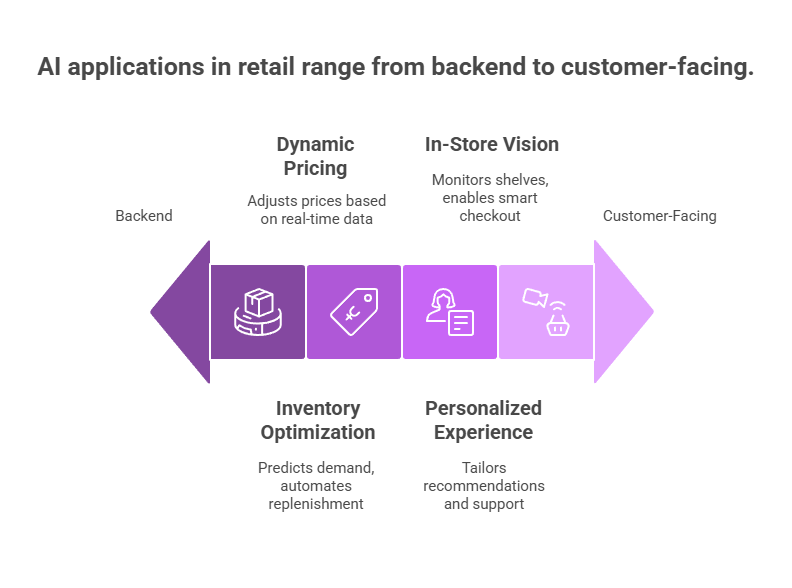
The in-store shopping experience is evolving rapidly, and computer vision powered by AI is at the forefront of this transformation. By using cameras and sensors combined with intelligent algorithms, retailers can now monitor and optimize physical store environments like never before.
One of the most exciting applications is smart checkout systems. These systems use computer vision to recognize products as shoppers place them in their carts or bags, allowing them to walk out of the store without waiting in line or scanning items manually. Amazon Go is a popular example, where “Just Walk Out” technology has redefined what convenience looks like in retail.
Other startups like Caper AI and Cloudpick are also innovating with AI-powered checkout carts and shelf recognition systems. These tools speed up the checkout process but also reduce the need for human cashiers, helping stores cut labor costs and redeploy staff to higher-value tasks like customer service.
AI-based loss prevention systems are another big win. Retailers can now detect unusual behavior or theft attempts in real time using computer vision and behavioral analytics. For example, if someone is lingering too long near high-value items or trying to conceal merchandise, the system can flag this for review, often before a loss even occurs.
Computer vision also enables smart shelving that tracks product levels visually and sends alerts when an item needs restocking. This ensures shelves are always full and attractive — a key factor in boosting sales and improving customer satisfaction.
With the help of Intel’s RealSense technology and edge AI capabilities, retailers can deploy these vision systems without requiring massive cloud infrastructure. These systems process data locally, delivering fast insights and reducing latency, which is essential for real-time applications like checkout or theft detection.
In short, computer vision is turning stores into intelligent environments that can react and adapt just like a human — only faster and more accurately.
Retail success isn’t just about what happens in-store or online — it’s also about getting the right product to the right place at the right time. That’s why supply chain and logistics are some of the most crucial areas where AI is making a big impact.
Traditional supply chains are often reactive. They respond to issues after they occur — late shipments, stockouts, or overstock problems. But AI enables a proactive, predictive supply chain that can foresee and mitigate issues before they happen.
For example, AI can analyze weather patterns, traffic conditions, historical data, and even social media chatter to forecast disruptions and optimize delivery routes. Retailers can then reroute shipments, adjust delivery times, or shift inventory between locations in real-time.
One of the most powerful tools in this area is vehicle routing optimization. AI algorithms consider hundreds of variables — like fuel efficiency, driver schedules, and delivery windows — to generate the most efficient routes for delivery trucks. This not only reduces costs but also helps companies meet tighter delivery expectations from customers.
AI-powered warehouse robots like those from Bossa Nova Robotics or Kiva Systems (used by Amazon) are revolutionizing logistics by automating repetitive tasks such as scanning shelves, moving inventory, and picking orders. These robots work 24/7, minimize errors, and boost fulfillment speed.
Moreover, empty shelf detection — a growing problem especially in high-traffic retail locations — is being addressed with real-time AI monitoring systems. Using cameras and visual recognition software, retailers can instantly spot out-of-stock items and trigger replenishment, reducing lost sales opportunities.
AI is also instrumental in last-mile delivery, which is often the most expensive and complex part of the supply chain. By integrating real-time GPS data, delivery preferences, and AI optimization, retailers can improve delivery success rates and reduce operational headaches.
In a world where same-day and even one-hour deliveries are becoming the norm, AI isn’t just a luxury — it’s the backbone of modern, agile supply chains that can scale quickly and operate efficiently.
Retailers lose billions of dollars annually due to theft, fraud, and administrative errors — collectively known as shrinkage. Fortunately, AI is helping to fight back with smarter, faster, and more precise loss prevention solutions.
AI-driven loss prevention systems use a combination of computer vision, behavioral analytics, and sensor data to monitor store activity and detect suspicious behavior in real time. These systems can identify patterns that humans might miss, such as repeated visits by the same person to specific store areas or unusual shopping routes that deviate from typical consumer behavior.
Advanced camera analytics can track movements and detect actions like hiding merchandise, swapping tags, or skipping the checkout process. These insights allow store managers to intervene quickly or review flagged footage without having to comb through hours of recordings.
What makes AI especially powerful in this domain is its ability to learn and adapt. Over time, the system becomes better at distinguishing between legitimate shoppers and potentially fraudulent actions, reducing false positives and ensuring smoother customer experiences.
AI is also being integrated into point-of-sale systems to flag suspicious transactions, such as excessive returns, invalid coupons, or mismatched SKUs. These alerts help prevent fraud and identify trends that may point to internal theft or policy loopholes.
Retailers are also using smart shelf technology that detects when items are removed without being scanned. Combined with real-time inventory tracking and camera systems, this creates a digital safety net that significantly reduces opportunities for theft.
With shrinking profit margins and increasing operational costs, even a small reduction in shrinkage can lead to substantial financial benefits. AI doesn’t replace traditional security systems — it enhances them by adding a layer of intelligence that’s always alert, always learning, and always improving.
For AI to truly thrive in retail environments, especially in physical stores, it needs the right infrastructure. This is where Edge AI comes into play. Unlike cloud-based systems that rely on sending data to distant servers, edge AI processes data locally, on devices like smart cameras, kiosks, and sensors. This local processing results in faster decision-making, reduced latency, and better real-time performance — all critical in retail settings.
Retailers are increasingly investing in edge computing infrastructure because it’s more efficient and secure. For instance, a smart shelf that detects low inventory levels needs to send signals instantly to restock systems. If this data had to travel back and forth to the cloud, it would create delays. But with edge AI, these insights happen on the spot, making operations smoother and quicker.
Intel’s RealSense technology and OpenVINO toolkit are two key tools enabling these advancements. They allow developers to deploy AI models directly on edge devices, which can then handle complex tasks like facial recognition, object detection, and customer flow analysis. These tools are not just theoretical — they’re already being used in real stores to monitor foot traffic, optimize product placements, and enhance security.
Another major benefit of edge AI is privacy. Because data doesn’t need to be transmitted to external servers, it reduces the risk of data breaches and ensures compliance with data protection regulations like GDPR and CCPA. For customers, this means a better shopping experience that doesn’t compromise their personal data.
Large-scale AI infrastructure often involves partnerships with cloud and hardware giants. For instance, Hitachi and Microsoft have announced multi-billion-dollar collaborations to bring AI and cloud innovation to retail. These investments are helping retailers of all sizes to implement AI in a scalable and cost-effective way.
Whether it’s enabling cashier-less checkout, tracking product movement in real time, or enhancing visual merchandising, Edge AI is the backbone of intelligent, responsive, and scalable retail experiences.
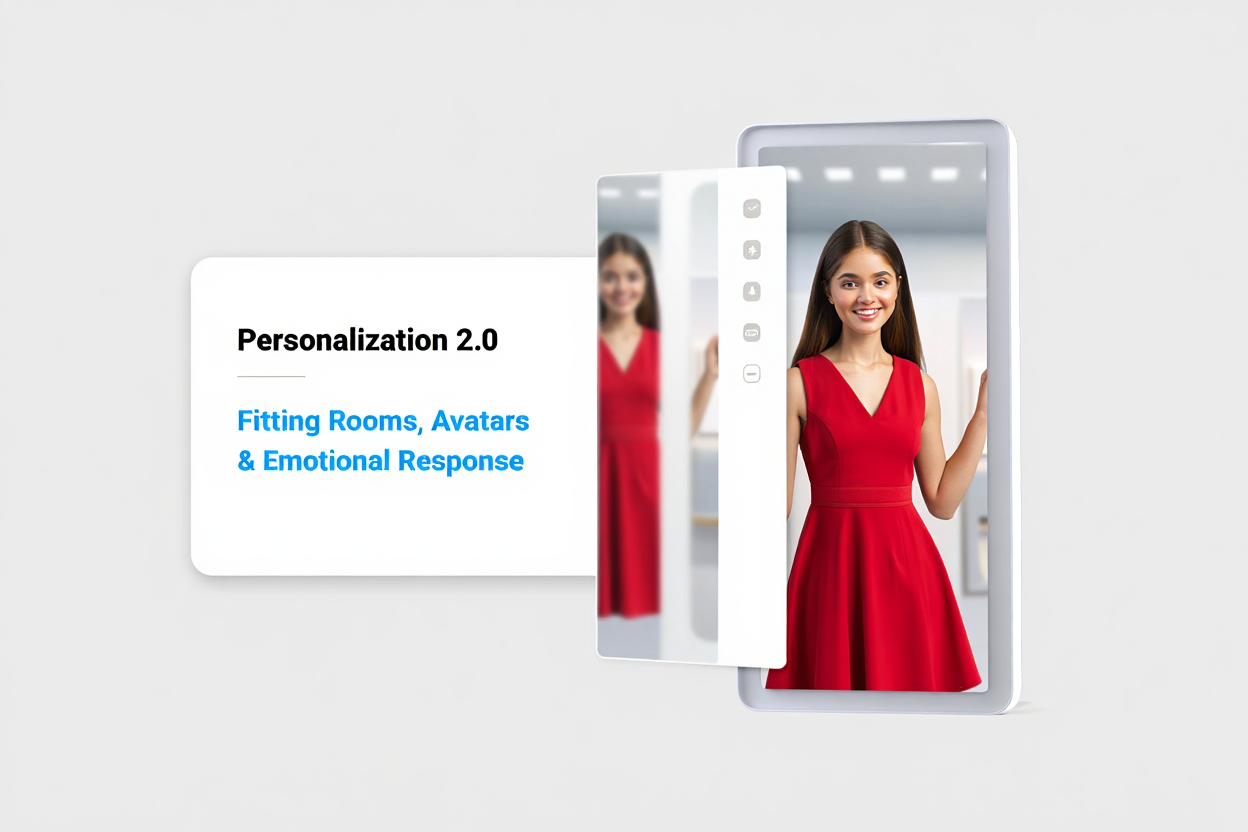
We’ve already touched on personalization, but AI is pushing the boundaries even further into next-level personalized shopping. Welcome to Personalization 2.0 — where AI doesn’t just guess what you want, it virtually brings your preferences to life.
One of the most exciting innovations is the AI-powered fitting room experience. Brands like FIT:MATCH are using 3D body scanning to create digital avatars of shoppers. Based on this avatar, the system recommends clothing items that are guaranteed to fit and flatter. No more frustrating try-on sessions or size guesswork. It’s like having a virtual stylist in your pocket.
These virtual fitting rooms aren’t just convenient — they also reduce return rates, a major pain point in online retail. When customers are confident about the fit and style, they’re more likely to keep their purchases. Retailers save on reverse logistics, and customers enjoy a smoother shopping journey.
Another breakthrough is emotional AI — systems that can detect a shopper’s emotional state through facial expressions, tone of voice, or body language. Imagine a store that can sense when a customer is confused, bored, or excited, and then adjust the lighting, product suggestions, or assistance accordingly. It sounds futuristic, but it’s already being tested in pilot programs across Asia and Europe.
AI-powered avatars are also playing a big role in creating immersive experiences. These digital representations of customers can try on clothes, accessories, or makeup in real-time — either on a screen in-store or via a mobile app. Some retailers even use AR (Augmented Reality) to project these avatars into virtual showrooms or mirror displays.
The goal of all these technologies is the same: to create highly engaging, personalized shopping experiences that feel intuitive and delightful. And as AI continues to evolve, the line between online and offline personalization will continue to blur, giving shoppers the best of both worlds.
AI isn’t just about automation or personalization — it’s also revolutionizing how retailers understand and act on their data. In a world where data is being generated at breakneck speed, AI-powered analytics is turning raw information into actionable intelligence.
Traditional business intelligence (BI) tools were often limited by human bandwidth — analysts could only sift through so much data at a time. But AI can process millions of data points across multiple channels — POS systems, e-commerce platforms, loyalty apps, social media, and more — to generate deep, accurate insights.
For example, AI can help retailers develop a 360-degree view of their customers by connecting the dots between in-store behavior, online activity, purchase history, and demographic data. This holistic view allows brands to segment their audience with surgical precision and tailor marketing efforts accordingly.
With predictive analytics, AI doesn’t just tell retailers what happened — it tells them what’s likely to happen next. Whether it’s forecasting future sales, predicting churn, or identifying emerging product trends, AI enables faster, data-driven decisions that drive growth.
Retailers also benefit from real-time dashboards that visualize AI insights in intuitive formats. These dashboards help store managers track KPIs like foot traffic, average transaction value, or out-of-stock items — all in real-time. This enables faster adjustments to staffing, merchandising, or promotions.
Tools like Hitachi’s Empower Data Platform are built specifically for retail, combining AI with robust governance, security, and scalability. They ensure that data is clean, accessible, and compliant — critical factors for trust and effectiveness.
With AI-powered BI, retailers can move from being reactive to being proactive and predictive. They can test strategies faster, uncover hidden opportunities, and outmaneuver the competition — all while improving customer satisfaction and operational efficiency.
Investing in artificial intelligence might sound expensive at first glance, but the return on investment (ROI) tells a different story. In fact, AI-driven initiatives are proving to be some of the most profitable investments that modern retailers can make.
Let’s start with the numbers. According to McKinsey & Company, retailers who leverage AI across their value chains can expect to see cost reductions of up to 20%, and revenue increases ranging from 6–10% just from personalized recommendations alone. That’s a significant performance uplift in an industry known for its razor-thin margins.
But how exactly is ROI measured when it comes to AI in retail? It’s not just about sales — although that’s a big part of it. Retailers look at multiple metrics:
AI also contributes to brand perception. Shoppers are more likely to trust and engage with brands that offer smart, seamless, and relevant experiences. For example, customers using AI-driven chatbots or virtual assistants report higher satisfaction rates, especially when the technology helps them solve problems faster.
Stock market data supports this trend. Many public companies that have invested in AI — including Amazon, Target, and Walmart — have seen positive investor sentiment and improved share performance. Investors recognize that AI capability is no longer a differentiator — it’s a requirement for future growth.
Bottom line? The business impact of AI isn’t hypothetical — it’s measurable, scalable, and profitable. Retailers who embrace it early will have a massive edge over those who wait.
Of course, adopting AI in retail isn’t without its challenges. Like any transformative technology, it comes with risks, roadblocks, and a steep learning curve. However, understanding these hurdles — and how to overcome them — is key to successful implementation.
AI systems are only as good as the data they’re trained on. Inconsistent, outdated, or siloed data can severely limit AI’s effectiveness. Many retailers struggle with integrating data from various sources — online, in-store, CRM systems, logistics — into a unified platform.
Best Practice: Invest in data infrastructure first. Build a centralized, clean, and standardized data lake before deploying AI tools. Data governance platforms like Hitachi’s Empower can help streamline this process.
With great data comes great responsibility. Retailers must navigate a complex web of data privacy laws like GDPR in Europe or CCPA in California. Mishandling customer data can lead to legal trouble and reputational damage.
Best Practice: Be transparent about data usage. Offer opt-ins for data collection, anonymize personal information where possible, and ensure systems are secure. Prioritize ethical AI practices to build trust with customers.
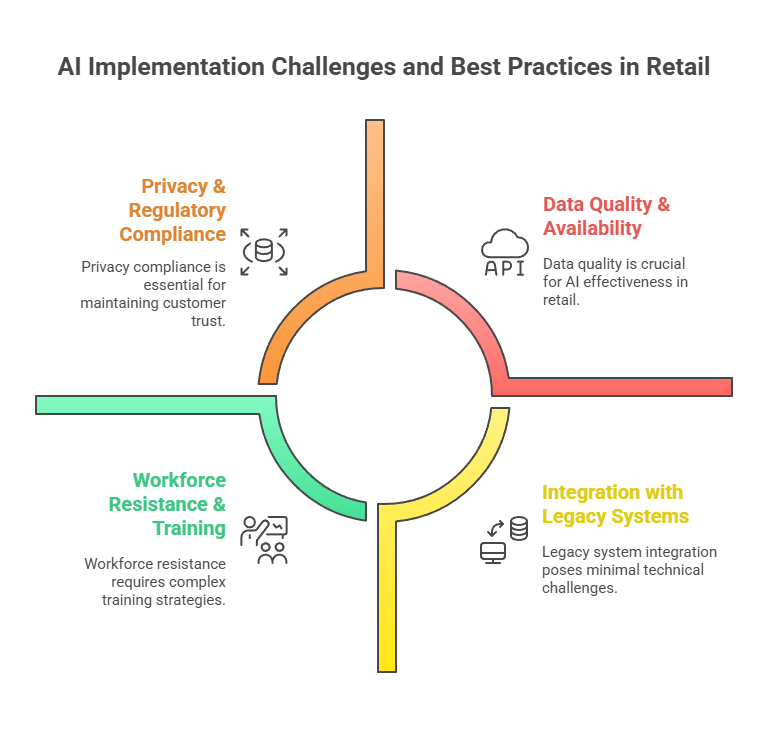
Older POS systems, ERPs, or store management tools might not play nicely with modern AI platforms. This makes integration a technical and financial headache.
Best Practice: Choose modular AI solutions that offer APIs and compatibility with existing software stacks. Gradual integration via pilot projects can also help smooth the transition.
Employees may view AI as a threat to their jobs, leading to resistance or poor adoption of new tools. On the other hand, staff might lack the skills to use AI solutions effectively.
Best Practice: Communicate the value of AI as an assistant, not a replacement. Offer training programs and involve employees in the implementation process to ensure buy-in.
AI deployment — especially for infrastructure-heavy systems like smart shelves or robotics — can be expensive initially.
Best Practice: Start small. Use cloud-based or subscription AI tools to minimize upfront investment. Prove ROI with limited pilots before scaling organization-wide.
Retailers that approach AI adoption with clear goals, realistic expectations, and a commitment to ongoing learning will find that the benefits far outweigh the challenges.
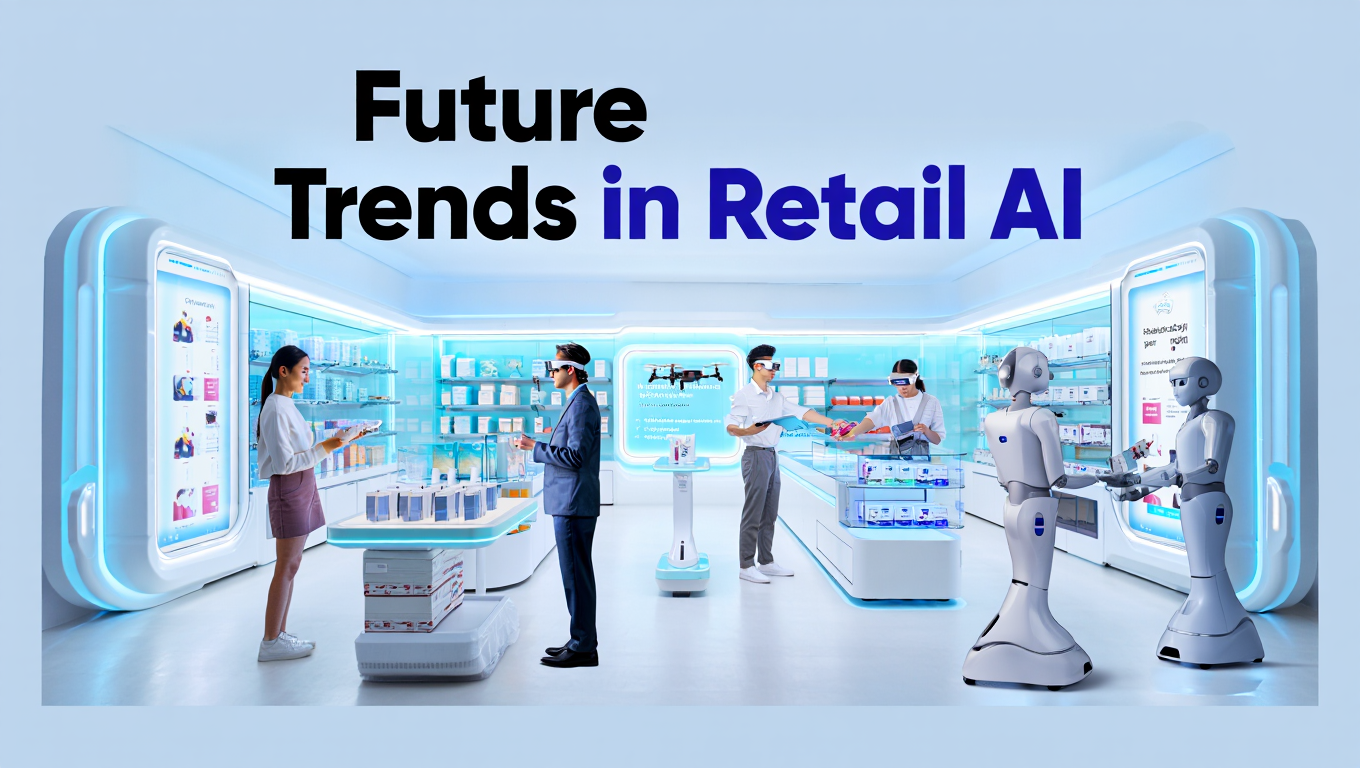
The AI landscape is constantly evolving, and the future of retail promises even smarter, faster, and more immersive experiences. Here are some of the emerging trends that will define the next phase of AI in retail:
AI isn’t just analyzing data anymore — it’s creating. Generative AI tools can now design product mockups, generate marketing copy, or even write product descriptions. Retailers are using this to speed up campaign launches, A/B test creative ideas, and reduce content production costs.
Imagine pointing your phone at a product and seeing a virtual demo or receiving an AI-generated explanation. AR combined with AI will make shopping more interactive, both online and in physical stores.
With the rise of voice assistants like Alexa and Google Assistant, more shoppers are placing orders using voice commands. AI will make these interactions smoother, context-aware, and personalized.
Some AI systems are learning to read emotions through facial expressions, posture, or even biometric signals. These insights can help stores adjust music, lighting, or service in real time to create mood-based shopping environments.
From stocking shelves to managing warehouses to assisting customers, AI and robotics will automate nearly every aspect of retail operations. Expect to see fully autonomous stores — with no staff and total AI control — becoming more common in the next 5–10 years.
As AI becomes more sophisticated, the demand for powerful yet energy-efficient hardware will increase. Intel’s Advanced Matrix Extensions (AMX) and oneAPI are examples of how chipmakers are future-proofing AI applications.
For retailers, staying ahead of these trends will be crucial. Those who innovate early will gain a significant edge, while laggards risk being left behind in an increasingly AI-first world.
Artificial intelligence is no longer just a term; it is the driving force behind retail innovation, development, and transformation. From personalized suggestions and dynamic pricing to automated logistics and smart store experiences, AI is permeating every aspect of retailing.
Leading companies are already benefiting from AI, which they use to improve customer satisfaction, expedite processes, and maintain their competitiveness in a market that is changing quickly. And, with developing technologies like generative AI, computer vision, and edge computing on the rise, we are only scraping the surface of what is possible.
Now is the moment to take action. Retailers who adopt AI now will lay the groundwork for future success. Whether you’re a worldwide corporation or a little boutique, investing in AI is no longer optional; it’s required.
